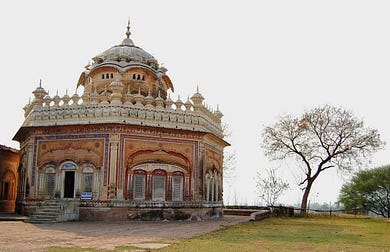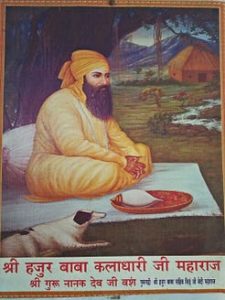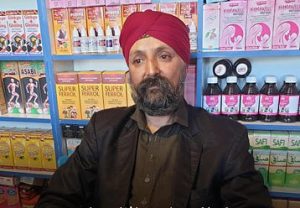
Many Bedis trace their descent from Baba Lakhmi Chand, the son of Guru Nanak.
RATTAN SINGH
The Bedis are a small clan among the Khatris, gaining distinction due to the birth of Guru Nanak into it. Many Bedis trace their descent from Baba Lakhmi Chand, the son of Guru Nanak. The Bedis historically congregated at Dera Baba Nanak but eventually created more centers at Una and Kallar. Their role in Punjabi society was varied, including acting as a theocratic elite and at other times, performing roles suited to the development of their village.
Theocratic elite
As mentioned before, Bedis were considered the descendants of Guru Nanak. As a result, they were treated as a theocratic elite and would receive patronage under various kingdoms due to their wide influence.
Baba Kaladhari

Dera Baba Nanak was founded by Guru Nanak, on the banks of the Ravi, alongside Kartarpur. The Bedis traditionally resided here until Baba Kaladhari, the ninth descendant of Guru Nanak, created further establishments including Una and the village of Bedian near Lahore. The Una establishment was founded by Baba Kaladhari, during the time of the 10th Guru. Nearby, Baba Kaladhari met Guru Gobind Singh at Bathu, where the Gurudwara Sri Gurplaha Sahib stands today. Since Una became a burgeoning pilgrimage centre, the Raja of Jaswan granted Baba Kaladhari several jagirs.
Baba Sahib Singh Bedi
After the death of his father Baba Ajit Singh, Baba Sahib Singh Bedi became the primary jagirdar of Una, gaining immense popularity throughout Doaba. Maharaja Ranjit Singh offered him further jagirs of villages in Gujranwala and Lahore. He is perhaps best known for his coronation of Maharaja Ranjit Singh as the emperor of the Sarkar-i-Khalsa. Satbir Singh Bedi’s pamphlet on Baba Sahib Singh Bedi further describes the event:
1801 ਦੀ ਵੈਸਾਖੀ ਨੂੰ ਸ਼ਾਹੀ ਕਿਲੇ ਵਿਚ ਬਾਬਾ ਜੀ ਨੇ ਆਪ ਅਰਦਾਸ ਕਰਕੇ ਸਿੰਘ ਸਾਹਿਬ, ਮਹਾਰਾਜਾ ਰਣਜੀਤ ਸਿੰਘ ਆਖ ਕੇ ਵਰ ਦਿਤਾ ਤੇ ਮਥੇ ਉਤੇ ਕੇਸਰ ਦਾ ਤਿਲਕ ਲਗਾਇਆ। ‘ਸਤਿ ਸ੍ਰੀ ਅਕਾਲ’ ਦੇ ਜੈਕਾਰੇ ਛਡੇ ਗਏ। ਬਾਬਾ ਸਾਹਿਬ ਸਿੰਘ ਜੀ ਦਾ ਕਿਤਨਾ ਕੁ ਪ੍ਰਭਾਵ ਮਹਾਰਾਜਾ ਰਣਜੀਤ ਸਿੰਘ ਉਤੇ ਸੀ ਇਸ ਦਾ ਮੁਖ ਉਦਾਹਰਣ ਨਾਨਕ ਸ਼ਾਹੀ ਸਿੱਕਾ ਹੈ ।
On the Vaisakhi of 1801, Baba Sahib Singh Bedi performed ardas in the royal fort of Lahore, gave him the title of Maharaja and anointed him with a saffron tilak. Rallying cries of ‘Sat Sri Akal’ were heard. Baba Sahib Singh Bedi’s influence on Maharaja is visible from the Nanakshahi coin.
It was only under Maharaja Ranjit Singh that upkeep became prominent as jagirs were granted to influential Bedis such as Baba Sahib Singh Bedi, the grandson of Baba Kaladhari. Under Maharaja Ranjit Singh, Gurudwara Dera Baba Nanak was reconstructed with a marble floor and a guiled throne.
Baba Khem Singh Bedi
Baba Khem Singh was born from the Kallar branch of Bedis. He was given jagirs under the Sikh and British administration both. Under the British, his support was frequently called for due to his influence in Rawalpindi. He contributed to the opening of 50 schools with a specific insistence of progressing female education. Afterwards, he co-founded the Singh Sabha movement, particularly funding a Sanatan strand of Sikhi; a strand that was more liberal on living Gurus and other folk traditions. Many of Khem Singh Bedi’s followers would accept him as a living Guru. Bhagat Lakshman Singh’s autobiography describes Khem Singh Bedi’s appearance when riding to villages:
His figure was small and complexion rather dark. His eyes too were not very particularly bright. But he made up for all this by the costume he wore. He seems to have studied how to look grand and majestic. He rode out daily for Shikar with a hawk perching on his left hand. This position he carefully maintained even when presiding at the daily congregations. And if his idea was to actually look like the illustrious Guru Gobind Singh, it may be safely stated that he succeeded in this endeavor to no small extent. His followers believed him to be an avatar whose mere touch would save them.
Despite his transgressions, he would fulfil his role as a parcharak in the hinterlands of the subcontinent and Punjab. With the growing influence of Bedis, many would become headmasters or teachers, helping to grow education across Punjab and the Khyber.
Folk medicine practitioners

It is already well known that specific castes and tribes played specific roles in Punjabi society historically. Mirasis, Sainis and Bhats were all known for their role as genealogists alongside other roles, dependent on region. Bangalis would act as both snake charmers and herbal practioners, using esoteric medicine like giddar singhi (jackal’s horn) and billi di jer (cat’s placenta).
Since the Bedis were part of a Sikh elite, they were considered a distinguished community in a village setting and weren’t subject to any discrimination unlike the aforementioned groups. One of the less mentioned roles of Bedis was as folk medicine practitioners, able to cure fevers and malaria through various folk remedies. The novelist Dr. Sohinder Singh Wanjara Bedi in his autobiography ‘Adhi Mitti Adha Sona’ describes the potential origin of Bedis in curing intermittent fever in villages:
The first one details that once a patient of intermittent fever came to Guru Nanak when he was resting under a tree in the forest. He asked the patient to fetch gur (jaggery) from somewhere. When that man returned with jaggery, Guru Nanak removed the web of a spider, mixed it up with the jaggery and asked him to eat it. He was at once relieved of the fever. Since then the descendants of Guru Nanak are endowed with that blessing.
An alternate story attributes a Muslim fakir who cured a Bedi through rat excrement and jaggery instead. That fakir visited the Bedi village and was paid deep respects. Since the fakir was impressed, he granted the sarpanch of the Bedi village with the ability to cure malaria. This practice carried on until the early 1900s among the Bedis of Rawalpindi. As modern medicine became available, the role of Bedis as folk medicine practitioners declined. By the late 1940s, the Bedis of Rawalpindi had stopped performing folk medicine. Despite this, a few Bedis would still work as unani hakims (herbal medicine practitioners) in Afghanistan.
Conclusion
Due to the influence of Bedis through jagirs by Sarkar-i-Khalsa and then the British, they were able to act as a noblesse oblige to fund education and create institutions for the Sikh community, similar to the Sayyids among Indian Muslims. Due to the protestant influence among the Lahore Singh Sabha becoming more prominent, the Bedis’ influence slowly waned and other laymen were able to fulfil the role of parcharaks and religious intellectuals. By the end of the Akali movement, Bedis were only influential in select areas and some gurudwaras. With urbanization, Bedis lost their traditional customs including herbal medicine.
____________________
Courtesy: The Khalsa Chronicle (Received by email on Feb 4, 2023)